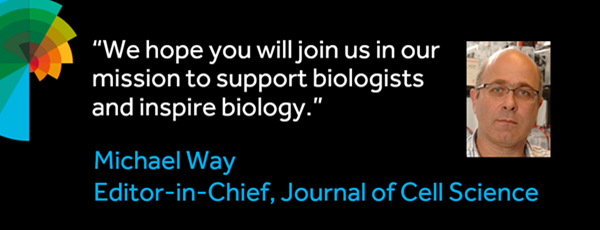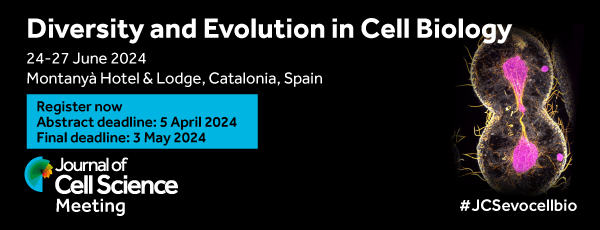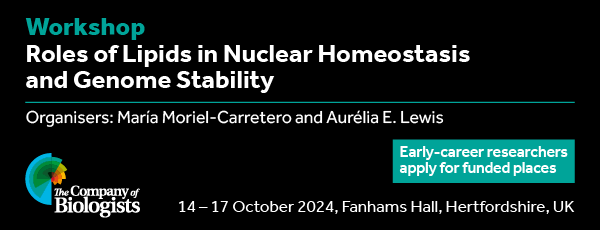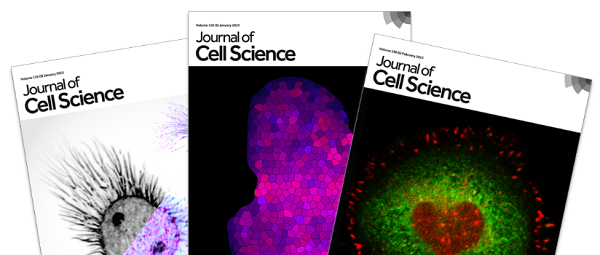Issues
-
Cover image
Cover Image

Cover: The image shows the single flagellum of a Leishmania parasite changing its beating behaviour. It is a composite made from successive frames of a high-magnification, high-frame-rate video lasting just a few seconds. Successive frames run in columns from top left to bottom right, showing the fluorescently labelled flagellum switching from one beat type to another. See article by Z. Wang et al. (jcs246637).
- PDF Icon PDF LinkTable of contents
- PDF Icon PDF LinkIssue info
RESEARCH HIGHLIGHTS
EDITORIAL
STICKY WICKETS
FIRST PERSON
CELL SCIENTISTS TO WATCH
CELL SCIENCE AT A GLANCE
Blood platelet formation at a glance
Summary: Blood platelets are produced by megakaryocytes in the bone marrow. Here, we discuss the mechanisms of megakaryocyte differentiation and how bona fide platelets are brought into circulation.
HYPOTHESIS
Biomechanical regulation of focal adhesion and invadopodia formation
Summary: We hypothesize that similar mechanosensitive mechanisms drive focal adhesions and invadopodia initiation and maturation, despite the differences in their morphology and functions.
REVIEWS
The multifaceted functions of ATG16L1 in autophagy and related processes
Summary: ATG16L1 has numerous essential activities in autophagy, autophagy-related processes and inflammatory responses. This review summarises these functions of ATG16L1 and discusses their implications.
The importance of water and hydraulic pressure in cell dynamics
Summary: Review of how the flow of water across the cell surface impacts cell volume regulation, cell force generation, cell shape and cell movement in physiologically relevant environments.
SHORT REPORT
Keratin 17 regulates nuclear morphology and chromatin organization
Highlighted Article: Keratin 17 (K17) is a non-lamin IF protein that functions in the cell nucleus. K17 is here shown to regulate nuclear morphology, chromatin organization, LAP2 localization and cell proliferation.
RESEARCH ARTICLES
Molecular mapping of transmembrane mechanotransduction through the β1 integrin–CD98hc–TRPV4 axis
Summary: Mechanical signal transfer between cell surface β1 integrin receptors, CD98hc and TRPV4 channels within focal adhesions is shown to mediate ultrarapid transmembrane mechanochemical conversion in endothelial cells.
Nucleolar size regulates nuclear envelope shape in Saccharomyces cerevisiae
Summary: Nucleolar size influences nuclear shape in yeast. Nucleolar expansion triggers phospholipid biosynthesis leading to nuclear envelope shape abnormalities.
TDP-43 dysfunction results in R-loop accumulation and DNA replication defects
Summary: TDP-43 deficiency increases the transcription-dependent accumulation of R-loops and perturbs DNA replication in proliferating cells. This R-loop accumulation, in turn, compromises genomic integrity in human cells, including neurons.
UV damage induces G3BP1-dependent stress granule formation that is not driven by mTOR inhibition-mediated translation arrest
Summary: The catalytic activity of GCN2 is important for G3BP1-dependent stress granule formation in response to UV damage, but neither eIF2α phosphorylation nor mTOR inhibition are involved in the mechanism.
Stbd1 promotes glycogen clustering during endoplasmic reticulum stress and supports survival of mouse myoblasts
Highlighted Article: ER stress in mouse myoblasts activates a cell survival mechanism that involves the upregulation of Stbd1 expression that is required for the formation of glycogen-containing structures.
Mitofusin 2 but not mitofusin 1 mediates Bcl-XL-induced mitochondrial aggregation
Summary: MFN2 and MFN1 play different roles in binding to Bcl-2 family proteins to regulate mitochondrial networks.
Smoothened receptor signaling regulates the developmental shift of GABA polarity in rat somatosensory cortex
Summary: The smoothened receptor controls the time course of inhibitory transmission by regulating stability of the potassium-chloride cotransporter KCC2 at the plasma membrane.
Mucin-type O-glycosylation controls pluripotency in mouse embryonic stem cells via Wnt receptor endocytosis
Summary: Mucin-type O-glycosylation regulates mouse embryonic stem cell pluripotency by directly modulating the endocytosis of the Wnt receptor frizzled-5, finely tuning the Wnt signaling outcome.
The cationic amino acid exporter Slc7a7 is induced and vital in zebrafish tissue macrophages with sustained efferocytic activity
Highlighted Article: The cationic amino acid exporter Slc7a7 is rapidly induced in zebrafish tissue macrophages upon efferocytosis, allowing them to cope with the catabolism of numerous dead cells without compromising their own viability.
The single flagellum of Leishmania has a fixed polarisation of its asymmetric beat
Highlighted Article: By using high speed, high-resolution fluorescence microscopy of swimming Leishmania cells, we showed that the asymmetric flagellar beat always wafts in the same direction and investigate which structures are involved.
Depression-like behaviors induced by defective PTPRT activity through dysregulated synaptic functions and neurogenesis
Summary: The physiological roles of PTPRT in hippocampal neurogenesis and synaptic function are involved in the pathogenesis of depressive disorder.
Overexpression of Mdm36 reveals Num1 foci that mediate dynein-dependent microtubule sliding in budding yeast
Summary: Using Mdm36 as a tool to cluster Num1 at the cell cortex, this study reveals that there are two distinct populations of Num1, each mediating its role in spindle positioning and mitochondrial tethering, respectively.
RETRACTION
Journal of Cell Science - more than just a journal

People who know JCS well will know that we're more than just a journal and that our community – the cell biology community – really is at the heart of everything we do. Read the full Editorial by Editor-in-Chief Michael Way and Executive Editor Seema Grewal.
2024 Journal Meeting 'Diversity and Evolution in Cell Biology'

Registration is open for our 2024 Journal Meeting Diversity and Evolution in Cell Biology, which aims to bring together evolutionary biologists and cell biologists investigating diverse aspects of cellular physiology. Submit your abstract by 5 April. Final registration deadline: 3 May 2024.
Workshop: Roles of Lipids in Nuclear Homeostasis and Genome Stability

Early-career researchers interested in the roles of nuclear lipids, apply now for one of the ten funded places at this Workshop, which will take place 14-17 October 2024. Application deadline: 19 April.
Reasons to submit to Journal of Cell Science

There are many benefits to publishing in Journal of Cell Science - read more about why you should choose JCS or visit our submission page now.



